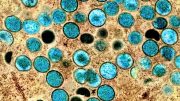
Scientists have discovered that poxviruses exploit a cellular protein to bypass host cell defenses, aiding their replication. Existing drugs targeting this protein have shown promise in restricting poxvirus spread, offering a durable treatment against various poxviruses, including monkeypox and smallpox.
Scientists have uncovered the mechanism by which poxviruses bypass cellular defenses and have identified existing drugs that can prevent this evasion.
Researchers examining the methods poxviruses use to bypass human cell defenses have pinpointed a potentially more durable treatment strategy than what’s currently available. This breakthrough came after their discovery of the mechanism by which poxviruses exploit a cellular protein to evade the host cell defenses, and thereby replicate and spread effectively.
Existing drugs, either for immunosuppression or treating different viral infections, target this same cellular protein. The scientists discovered that such drugs can also hinder the growth and propagation of poxviruses. By targeting the cell rather than the virus directly, this method makes it considerably more challenging for the virus to develop drug resistance.
And because this hijacking mechanism is the same across many poxviruses, the drugs will be effective in treating a range of diseases such as mpox and smallpox.
The research was recently published in the journal Nature.
Despite the fact that smallpox has been eradicated as a disease since 1979, the virus that causes it, variola, is still held in two high-security labs – one in the United States, and one in Russia. The threat of variola virus being used in bioterrorism has led to a drug, tecovirimat, being licensed to treat smallpox.
There is an ongoing epidemic of mpox (caused by monkeypox virus): although the number of infections has dropped in the UK it is still present, particularly in London, and in many other nations.
Tecovirimat has been used to treat severe cases of mpox over the last year, but this has resulted in the emergence of multiple drug-resistant strains of the monkeypox virus.
“The drugs we identified may be more durable than the current treatment for monkeypox – and we expect will also be effective against a range of other poxviruses including the one that causes smallpox,” said Professor Geoffrey L. Smith, who conducted the work in the Department of Pathology at the University of Cambridge, the Dunn School of Pathology, University of Oxford and the Pirbright Institute.
Once a poxvirus infects a host cell, it has to defend itself from attack by cellular proteins that would restrict virus replication and spread. Researchers identified a specific cell protein, called TRIM5α, that restricts virus growth – and another cellular protein called cyclophilin A that prevents TRIM5α from doing so. Existing drugs target cyclophilin A, and so make the virus more sensitive to TRIM5α.
“There are various drugs that target cyclophilin A, and because many of them have gone through clinical trials we wouldn’t be starting from scratch but repurposing existing drugs, which is much quicker,” said Smith.
Many other poxviruses affect animals, for example, a global pandemic of ‘Lumpy skin disease’ is currently affecting cattle – and can be fatal.
Smith added: “Our results were completely unexpected. We started the research because we’re interested in understanding the basic science of how poxviruses evade host defenses and we had absolutely no idea this might lead to drugs to treat monkeypox virus and other poxviruses.”
Professor Guy Poppy, Interim Executive Chair at the Biotechnology and Biological Sciences Research Council (BBSRC), said: “The national monkeypox consortium was borne out of an urgent need for the UK to respond to an emerging threat of disease caused by this virus. It is critical that public funders and policymakers are able to act with agility and coordination to support a swift scientific response.
“Taking a One Health approach, the rapid response by BBSRC and the Medical Research Council (MRC), in collaboration with policymakers via the UKRI Tackling Infections strategic theme, enabled leading researchers from across the UK to pool their expertise and deliver impactive results at pace.”
The science behind the discovery
The project started with the simple observation that vaccinia virus infection causes a reduction in the level of TRIM5α in human cells. To find out why, the team engineered human cells to lack TRIM5α and found that in these cells the virus replicated and spread better. This shows that TRIM5α has anti-viral activity.
Next, they identified the vaccinia virus protein that TRIM5α targets. They also discovered that the virus has two defenses against attack by TRIM5a: first, it exploits another cellular protein, cyclophilin A, to block the antiviral activity of TRIM5α, and second, it makes a protein, C6, that induces destruction of TRIM5α.
Existing drugs target cyclophilin A. When the team tested a series of these drugs against a range of poxviruses, including monkeypox, they had antiviral effects in all cases. The drugs work by making the virus more sensitive to TRIM5α.
Reference: “TRIM5α restricts poxviruses and is antagonized by CypA and the viral protein C6” by Yiqi Zhao, Yongxu Lu, Samuel Richardson, Meghna Sreekumar, Jonas D. Albarnaz and Geoffrey L. Smith, 9 August 2023, Nature.
DOI: 10.1038/s41586-023-06401-0
The study was funded by the Isaac Newton Trust, the Medical Research Council, and UK Research and Innovation.









Be the first to comment on "Existing Drugs Could Treat Poxviruses – Such As Monkeypox and Smallpox"